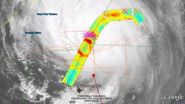(Press-News.org) Hurricane Earl lashed the North Carolina coast last night and this morning, September 3, and is now headed for Cape Cod, Massachusetts. This morning's image from the GOES-13 satellite saw Hurricane Earl's clouds covering most of the northeastern U.S.
The Geostationary Operational Environmental Satellite known as GOES-13 captured an image of Hurricane Earl at 7:32 a.m. EDT this morning, September 3. The image clearly showed a huge Hurricane Earl northeast of North Carolina with cloud cover stretching over the northeastern U.S. A disorganized Fiona was also seen southeast of Earl near Bermuda. GOES satellites are operated by NOAA, and images and animations are created by the NASA GOES Project at the NASA Goddard Space Flight Center, Greenbelt, Md.
Hurricane Warnings and Watches and Tropical Storm Warnings and Watches were in effect today from North Carolina to Massachusetts. For all warnings, visit: www.nhc.noaa.gov/.
At 8 a.m. EDT today, Earl was a Category 2 hurricane on the Saffir-Simpson scale with maximum sustained winds near 105 with higher gusts. Hurricane force winds extend outward up to 70 miles from the center and tropical storm force winds extend outward up to 205 miles.
At 8 a.m. EDT Dare County (North Carolina) regional airport North Carolina reported a wind gust to 70 mph. Estimated minimum central pressure is 955 Millibars.
The National Weather Service forecast for Nags Head, North Carolina for Friday calls for "Tropical storm conditions expected, with hurricane conditions possible. Showers, mainly before 11am with a high near 87. Northwest wind 45 to 55 mph decreasing to between 25 and 30 mph. Winds could gust as high as 75 mph." Nags Head is currently under a hurricane warning.
Earl is about 130 miles east-northeast of Cape Hatteras, North Carolina and 395 miles south-southwest of Nantucket, Mass., near 36.2 North and 73.6 West. It was moving north-northeast near 18 mph and is expected to turn toward the northeast between 8 p.m. EDT tonight and 8 a.m. EDT on Saturday. Earl will approach southeastern New England tonight.
INFORMATION:
GOES-13 satellite sees Hurricane Earl's clouds covering the US Northeast
2010-09-04
ELSE PRESS RELEASES FROM THIS DATE:
NASA hurricane researchers eye Earl's eye
2010-09-04
Hurricane Earl, currently a Category Two storm on the Saffir-Simpson scale with maximum sustained winds of 100 knots (115 miles per hour), continues to push relentlessly toward the U.S. East Coast, and NASA scientists, instruments and spacecraft are busy studying the storm from the air and space. Three NASA aircraft carrying 15 instruments are busy criss-crossing Earl as part of the agency's Genesis and Rapid Intensification Processes mission, or GRIP, which continues through Sept. 30. GRIP is designed to help improve our understanding of how hurricanes such as Earl form ...
AgriLife research hibiscus breeder comes up with the blue
2010-09-04
VERNON -- Dr. Dariusz Malinowski is seeing blue, and he is very excited.
For four years, Malinowski, an AgriLife Research plant physiologist and forage agronomist in Vernon, has been working with collaborators Steve Brown of the Texas Foundation Seed and Dr. William Pinchak and Shane Martin with AgriLife Research on a winter-hardy hibiscus breeding project.
The project was first a private hobby of the inventors and became a part of the strategic plan of the Texas AgriLife Research and Extension Center at Vernon in 2009. The flower commercialization is a part ...
Queen's study exposes cognitive effects of Parkinson's disease
2010-09-04
Researchers at Queen's University have found that people with Parkinson's disease can perform automated tasks better than people without the disease, but have significant difficulty switching from easy to hard tasks. The findings are a step towards understanding the aspects of the illness that affect the brain's ability to function on a cognitive level.
"We often think of Parkinson's disease as being a disorder of motor function," says Douglas Munoz, director of the Queen's Centre for Neuroscience Studies and a Canada Research Chair in Neuroscience. "But the issue is ...
Increase in Cambodia's vultures gives hope to imperiled scavengers
2010-09-04
While vultures across Asia teeter on the brink of extinction, the vultures of Cambodia are increasing in number, providing a beacon of hope for these threatened scavengers, according to the Wildlife Conservation Society (WCS) and other members of the Cambodia Vulture Conservation Project.
Researchers report that record numbers of vultures have been counted in Cambodia's annual vulture census, with 296 birds of three species found at multiple sites across the Northern and Eastern Plains of Cambodia by the Cambodia Vulture Conservation Project, a partnership of conservationists ...
Afla-Guard also protects corn crops
2010-09-04
Afla-Guard®, a biological control used to thwart the growth of fungi on peanuts, can be used on corn as well, according to a study by U.S. Department of Agriculture (USDA) scientists who helped develop it.
After extensive study and research trials in Texas, Afla-Guard® was registered by the U.S. Environmental Protection Agency (EPA) for use on corn, beginning with the 2009 crop.
Recently retired Agricultural Research Service (ARS) microbiologist Joe Dorner at the National Peanut Research Laboratory in Dawson, Ga., helped develop Afla-Guard®, a biological control for ...
Magnetism's subatomic roots
2010-09-04
The modern world -- with its ubiquitous electronic devices and electrical power -- can trace its lineage directly to the discovery, less than two centuries ago, of the link between electricity and magnetism. But while engineers have harnessed electromagnetic forces on a global scale, physicists still struggle to describe the dance between electrons that creates magnetic fields.
Two theoretical physicists from Rice University are reporting initial success in that area in a new paper in the Proceedings of the National Academy of Sciences. Their new conceptual model, which ...
MIT moves toward greener chemistry
2010-09-04
CAMBRIDGE, Mass. - Phosphorus, a mineral element found in rocks and bone, is a critical ingredient in fertilizers, pesticides, detergents and other industrial and household chemicals. Once phosphorus is mined from rocks, getting it into these products is hazardous and expensive, and chemists have been trying to streamline the process for decades.
MIT chemistry professor Christopher Cummins and one of his graduate students, Daniel Tofan, have developed a new way to attach phosphorus to organic compounds by first splitting the phosphorus with ultraviolet light. Their method, ...
Moonstruck primates: Owl monkeys need moonlight as much as a biological clock for nocturnal activity
2010-09-04
PHILADELPHIA –- An international collaboration led by a University of Pennsylvania anthropologist has shown that environmental factors, like temperature and light, play as much of a role in the activity of traditionally nocturnal monkeys as the circadian rhythm that regulates periods of sleep and wakefulness.
The study also indicates that when the senses relay information on these environmental factors, it can influence daily activity and, in the case of a particular monkey species, may have even produced evolutionary change. It is possible, according to the study results, ...
NASA imagery reveals a weaker, stretched out Fiona
2010-09-04
NASA satellite data has noticed that Tropical Storm Fiona is getting "longer." That is, the storm is elongating in almost a north-south direction, indicating that she's weakening and may not make it through the weekend. Meanwhile, forecasters are watching two other areas for development in the eastern Atlantic this weekend.
The Geostationary Operational Environmental Satellite, GOES-13 captured an image of Fiona on Friday, Sept. 3 at 10:32 a.m. EDT and the visible image showed a weak circulation in Fiona's center. It also appeared that Fiona's clouds were "stretched" ...
NASA satellite and International Space Station catch Earl weakening
2010-09-04
NASA satellites and the International Space Station are keeping eyes on Hurricane Earl as it heads for New England. Watches and Warnings are posted in the U.S. northeast.
Having felt the effects of both increasing wind shear and cooler waters, Hurricane Earl weakened to a Category 2 storm on the Saffir-Simpson scale with winds still powerful at 90 knots (104 mph) as it neared the North Carolina coast. It was at this time that the Tropical Rainfall Measuring Mission (TRMM) satellite captured the data about TRMM's rainfall rates.
The rainfall pattern associated with ...





